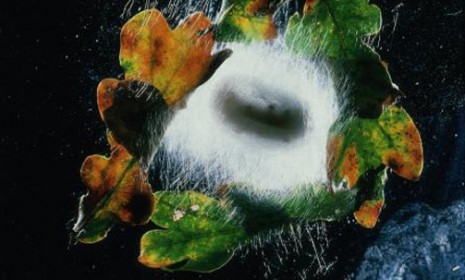The miracle 'spider silk' spun by genetically altered silkworms
Humans have long coveted the ultra-strong webbing of spiders — but it took a scientific breakthrough to actually harvest the stuff

Spiderwebs are 10 times tougher than Kevlar, and have enormous potential as a durable, flexible material. The only problem? The sticky fibers are nearly impossible for humans to harvest. But now, scientists from the University of Wyoming may have a found a manageable solution: Harvesting the coveted material from genetically engineered silkworms outfitted with spider DNA. Here's what you should know:
What's so great about spider silk?
"Spider silk is a remarkable material," says Ed Yong at Discover, "wonderfully adapted for trapping, crushing, climbing, and more. It is extraordinarily strong and tough, while still being elastic enough to stretch several times its original length." Humans could potentially use it for super-strong sutures, "artificial ligaments," or bulletproof vests.
The Week
Escape your echo chamber. Get the facts behind the news, plus analysis from multiple perspectives.

Sign up for The Week's Free Newsletters
From our morning news briefing to a weekly Good News Newsletter, get the best of The Week delivered directly to your inbox.
From our morning news briefing to a weekly Good News Newsletter, get the best of The Week delivered directly to your inbox.
Why is it so hard to harvest?
"Farming spiders is out of the question," says Yong. "They are territorial animals with a penchant for eating each other." And each spider produces a miniscule amount of silk. For example, just to create a single 44-square-foot piece of cloth, researchers spent more than four years working with roughly 1 million spiders.
And silkworms are a viable alternative?
They are, and they could "open the door for large scale production," says PhysOrg. Silkworm cocoons — which humans have been harvesting for centuries — "are capable of creating mile-long threads" at a time. To improve nature's formula, scientists placed spider silk genes into the glands of silkworms. The genetically altered silkworms were then able to secrete a super-strong composite fiber of both spider and silkworm silk.
A free daily email with the biggest news stories of the day – and the best features from TheWeek.com
What exactly is this composite fiber?
It's still mostly the worms' own silk, but "stronger, more elastic, and twice as tough as normal silkworm fibers," says Yong. The composite still has a long way to go before it can match the strength and elasticity of the real thing, though. The next step for researchers is to refine the technique, eventually removing the silkworms' proteins entirely so they can produce pure spider silk.
-
 5 fairly vain cartoons about Vanity Fair’s interviews with Susie Wiles
5 fairly vain cartoons about Vanity Fair’s interviews with Susie WilesCartoon Artists take on demolition derby, alcoholic personality, and more
-
 Joanna Trollope: novelist who had a No. 1 bestseller with The Rector’s Wife
Joanna Trollope: novelist who had a No. 1 bestseller with The Rector’s WifeIn the Spotlight Trollope found fame with intelligent novels about the dramas and dilemmas of modern women
-
 Codeword: December 20, 2025
Codeword: December 20, 2025The daily codeword puzzle from The Week